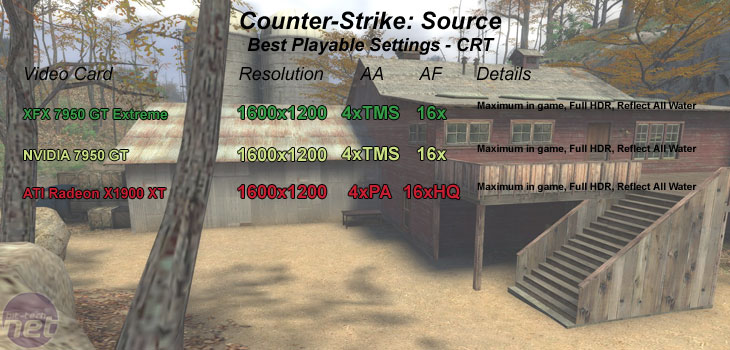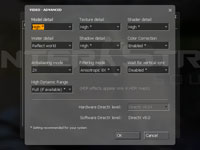For gameplay evaluations on a 24" widescreen monitor, please head straight to our widescreen performance section.
Counter-Strike: Source is one of the most widely played online titles in the world at the moment, making it an excellent test of mid-range hardware capability. Several levels (including Train, Militia, and Nuke) feature Valve's interpretation of high-dynamic range rendering. We used the most recent version of the game, and did three five minute portions of real world game play on the Militia map. We created a server on our internal network with 15 bots hosted on a different machine on the network.
Anti-aliasing and anisotropic filtering were controlled from inside the game, and thus the drivers were left set to "Application Controlled". There are three options for the method of HDR used in this title. You can either disable HDR completely, make use of "Bloom" which is just what it says and less resource hungry in comparison to "Full" which, again is just what it says. It utilises a full dynamic range with the iris effect too.
We have written quite a bit about Half-Life 2: Lost Coast, Day of Defeat: Source, Episode One and how Valve have implemented HDR in to the Source Engine. You can check out the articles listed below for more information on The Lost Coast & Day of Defeat: Source.
Militia is probably the most stressful map in the game and it serves well as a worst-case scenario for testing purposes. Thankfully though, the game runs superbly on a wide range of hardware, while still looking absolutely stunning.

 XFX's GeForce 7950 GT 570M Extreme didn't give us any additional gameplay benefits over either the Radeon X1900XT or the reference GeForce 7950 GT. However, it did result in a higher frame rate and a generally smoother gaming experience. When you're involved in larger, more intense games than our test scenario, you're going to see lower frame rates than what we saw here, so the minimum frame rate advantage will be beneficial.
XFX's GeForce 7950 GT 570M Extreme didn't give us any additional gameplay benefits over either the Radeon X1900XT or the reference GeForce 7950 GT. However, it did result in a higher frame rate and a generally smoother gaming experience. When you're involved in larger, more intense games than our test scenario, you're going to see lower frame rates than what we saw here, so the minimum frame rate advantage will be beneficial.
We had some headaches getting the Radeon X1900XT to work properly in Counter-Strike: Source. We re-ghosted our operating system to check that it wasn't a bad driver install and that didn't fix the problems. We've never had these problems before, but it seems that they could be related to the recent Counter-Strike: Source updates, as all of our CS: Source testing was completed after this update.
Transparency supersampling or quality adaptive anti-aliasing is just too much for these cards at 1600x1200 with 4xAA applied. We tried playing the game with transparency supersampling turned on with the XFX 7950 GT 570M Extreme and there were occasions where our frame rates dropped into the teens. The average frame rate was surpisingly good though at over 50 frames per second - it proves how important minimum frame rates are.
Counter-Strike: Source
Publisher: Valve SoftwareCounter-Strike: Source is one of the most widely played online titles in the world at the moment, making it an excellent test of mid-range hardware capability. Several levels (including Train, Militia, and Nuke) feature Valve's interpretation of high-dynamic range rendering. We used the most recent version of the game, and did three five minute portions of real world game play on the Militia map. We created a server on our internal network with 15 bots hosted on a different machine on the network.
Anti-aliasing and anisotropic filtering were controlled from inside the game, and thus the drivers were left set to "Application Controlled". There are three options for the method of HDR used in this title. You can either disable HDR completely, make use of "Bloom" which is just what it says and less resource hungry in comparison to "Full" which, again is just what it says. It utilises a full dynamic range with the iris effect too.
We have written quite a bit about Half-Life 2: Lost Coast, Day of Defeat: Source, Episode One and how Valve have implemented HDR in to the Source Engine. You can check out the articles listed below for more information on The Lost Coast & Day of Defeat: Source.
- Half-Life 2: Lost Coast HDR overview
- Half-Life 2: Lost Coast hands on
- Half-Life 2: Lost Coast Benchmarks & Video
- Cinematic Effects in Source
- Liveblogging HL2: Episode One
Militia is probably the most stressful map in the game and it serves well as a worst-case scenario for testing purposes. Thankfully though, the game runs superbly on a wide range of hardware, while still looking absolutely stunning.


We had some headaches getting the Radeon X1900XT to work properly in Counter-Strike: Source. We re-ghosted our operating system to check that it wasn't a bad driver install and that didn't fix the problems. We've never had these problems before, but it seems that they could be related to the recent Counter-Strike: Source updates, as all of our CS: Source testing was completed after this update.
Transparency supersampling or quality adaptive anti-aliasing is just too much for these cards at 1600x1200 with 4xAA applied. We tried playing the game with transparency supersampling turned on with the XFX 7950 GT 570M Extreme and there were occasions where our frame rates dropped into the teens. The average frame rate was surpisingly good though at over 50 frames per second - it proves how important minimum frame rates are.

MSI MPG Velox 100R Chassis Review
October 14 2021 | 15:04










Want to comment? Please log in.